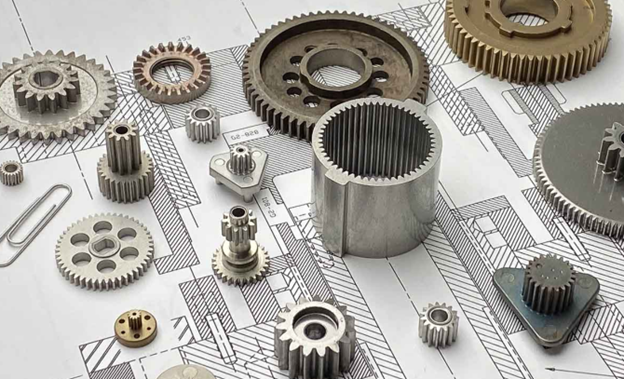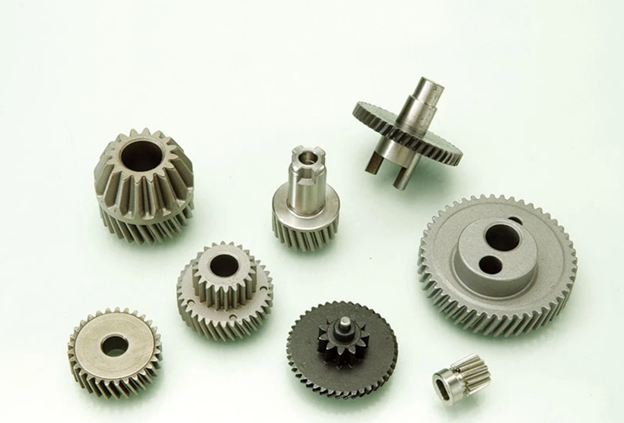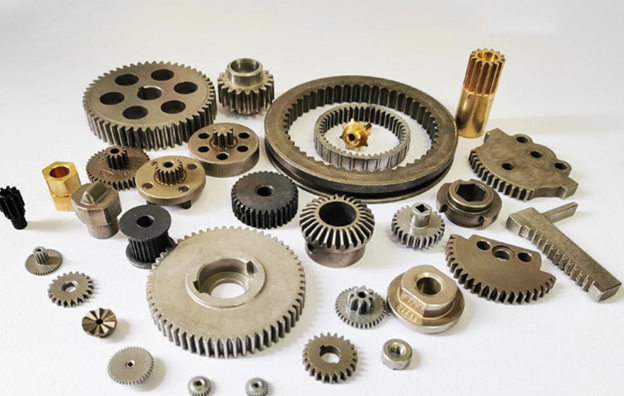Introduction
Why are sintered gears perfect for tough jobs? They’re strong and last a long time. In this blog, you will learn how sintered gears handle heavy loads. Machines work better because of them. Could sintered gears be what your machine needs?
What Are Sintered Gears?

Sintered gears are made by pressing metal powder into shapes. It puts heat together the particles. You can use sintered gears in cars, tools, and machines.
Gears can be very strong and reach hardness levels of 45 to 70 HRC. There are types of gears, such as spur, helical, and bevel. They are very accurately dimensioned, down to ±0.001 inches or better. Sintered gears are useful because they are tough, save energy, and can be made quickly and cost-effectively.
The Sintering Process: How Sintered Gears Are Made?
· Powder Mixing
You take small powders of iron or nickel. The powders are stirred very fast by machines. For example, some powders are down to 100 µm. About 1% of a little graphite in the mix makes it stronger.
The mix needs to be just right for making sintered gears. For this step, these powders are put into molds. Precise machines of high-quality powder mixing ensure top gear performance at JH MIM.
· Precision Compaction
You press the powder into some shape. It’s 400–800 MPa pressure pushed down by the punch. They get closer, and stick together. A ‘green compact’ is the compacted shape. More than one punch in a machine makes shapes stronger. Now the gear is ready for sintering.
· High-Temperature Sintering
The gear goes into a furnace to heat them up. It’s really hot stuff, 1100°C. At this step the particles join. The gear doesn’t melt. It stays strong. The gas keeps oxygen out, and sintered gears become even stronger. Sintering takes about an hour, and the furnace must be controlled as such. JH MIM comes with advanced sintering technology, which makes for durability, as well as strength.
· Controlled Cooling
The gear cools down after sintering. A gas helps cool the gear so as not to break. Cracks are caused when it cools too fast. The cooling is watched by special machines. Outside at high noon, the gear can cool evenly, stay strong and not change shape. Later, the gear will work well this step.
· Post-Treatment Options
The gear is ready for more work now. You can smooth out the surface. Some of the gear gets really hard by some special heat. Other times you coat them to provide wear protection.
If not tight enough, gears can be tightened or repressed to the perfect size. Therefore, the gear lasts longer in machines. To increase its life, we have a post treatment solutions like heat treatment and coating provided by JH MIM.
High Torque Applications: Why Sintered Gears Excel?

· Load-Bearing Capacity
Sintered gears hold heavy things. They don’t break easily. The maximum load these gears can handle is 100 MPa. They make good shaft and axle supports. With sintered gears, weight spreads evenly. That helps them last longer. They are stronger iron and copper alloys. These are the gears for the tough jobs you can count on.
· Torsional Strength
Sintered gears are very strong. They twist without breaking. They handle forces of 50 Nm. They are safe from breaking because of the grain structure. Sintered gears are great for engines.
Machines run smoothly, they say. This boasts the density of 7.4 g/cm³, which retains the toughness of the gears.
· Stress Distribution
These gears will deal with compression very well. They don’t wear down quickly. Each tooth takes its load on this evenly. Sintered gears spread force, stopping cracks. Powdered metal becomes strong by compacting it. Most often, the gears are iron based. They stay good when used.
· Shock Resistance
Sintered gears handle sudden hits. Up to 30 J can be taken by them without breaking. Due to their strong material, they remain safe from shocks. They are in cars and machines. Hit hard, these gears stay shaped. They work smoothly and last long.
· High Power Density
Sintered gears work in small spaces. They go with lot torque, up to 90 Nm. How they keep their strength with 7.6 g/cm³ density. The smaller they are, which means that they pack a lot of power. Machines with sintered gears run fast and use energy well. They will hold up.
| Feature | Sintered Gears | Machined Gears | Material Types | Load Capacity | Power Density |
| Load-Bearing Capacity | Handles up to 100 MPa | Handles higher loads, typically >200 MPa | Iron, Copper alloys | High | Moderate to High |
| Torsional Strength | Withstands 50 Nm torsion forces | Can exceed 150 Nm depending on the material | Astaloy Mo+0.2C, CrL alloys | Medium | High |
| Stress Distribution | Equal force distribution, minimizes cracks | More prone to uneven stress distribution | Powdered metals | Moderate | High |
| Shock Resistance | Absorbs up to 30 J without deformation | Higher shock resistance | Sintered iron, carbon alloys | Medium | High |
| Power Density | Achieves 90 Nm in compact designs | Lower density due to machining | Sintered steel | High | Very High |
| Precision Tolerance | Tolerances of ±0.03 mm achievable | Tolerances often tighter, ±0.01 mm possible | Various alloys | Moderate | High |
| Manufacturing Cost | Lower material wastage, cost-effective | Higher due to machining time and material use | Astaloy, sintered composites | Low | Moderate to High |
Table on High Torque Applications: Why Sintered Gears Excel!
Benefits of Sintered Gears in High-Load Systems!

· Cost Efficiency
You save money with sintered gears. They have proven the process requires 95% of materials. That means parts don’t require much machining, saving cost by 30%.
These are strong gears at 7.5 g/cm³. And because they are designed for efficient production, producing for you is faster. Sintered gears are the best for saving money and making lots of parts fast.
· Design Flexibility
Sintered gears can be made into many shapes. You also get cool designs such as helical gears with angled teeth. The density of these gears is 7.2 – 7.4 g/cm³. For example, they are helpful for various machines. Sintered gears work well in cars and gadgets that need strong parts without extra steps. You can trust their shapes for such hard jobs.
· Near-Net Shape
You don’t need to cut or shape sintered gears much. They come out almost perfect. It’s ready to go with only one additional step. Sintered gears use powders to make gears in sizes like 0.5 mm. It saves time and is easily generated for machines.
· Minimal Waste
Sintered gears are great because they don’t waste materials. Almost everything is used when you make them. These gears are strong, at 7.5 g/cm³. They’re perfect for saving the planet, making tough stuff and for making tough little parts. It’s smart to build strong, useful parts without excess waste: sintering.
· High-Volume Production
You can make many sintered gears at once. In one go, you can make more than 1,000 gears. These parts must be heated up to 1200°C to get strong. Cars and machines use them. They’re a lot of gears, and you get them quickly, and they work great for big jobs.
Material Properties That Enhance Torque Performance!
- Wear Resistance: Sintered gears are strong. They work well in machines. Their structure is special, it keeps them safe. They are tough, owing to their density of 7.6 g/cm³. Such loads can carry up to 1200 MPa. The adding of copper makes them even better. Sintered gears run smoothly, even when used for a long time. If machines want to last, they need gears like this.
- Alloy Customization: You can change sintered gears to fit different jobs. Gears use copper and carbon. They are strong thanks to these materials. However, it takes a hardness between 45 and 70 HRC. That makes them to be good at hard work. They can tough it out because of the sintering process. Because of these features these gears works in many machines.
- Heat Tolerance: Sintered gears can handle heat. They are stronger due to special treatments. The outside of carburizing makes them hard. At up to 70 HRC, they stay tough. However, they are cooled by the porous design. Heat building up is important where gears like this are located, such as in cars and machines.
- Durability Enhancements: These are meant to last. Powdered gears are strong. A load of up to 1300 MPa can be taken. The surface becomes even stronger by rolling them. Hard surface gears do not break easily. They are good for the machines that have to work very long hours.
- Increased Hardness: Sintered gears become hard through special processes. They can reach their hardness at 70 HRC. They will not scratch or crack. They last longer because of special heat treatment. It stays that strong all over because of the powder design. These are gears that keep machines strong under pressure.
Comparing Sintered Gears to Machined Gears for Torque Demands!

· Manufacturing Costs
Sintered gears are made in a way that uses very little material. For this reason, they are less costly to produce. And these gears waste less than 5% material. You can make lots of sintered gears without spending much. Besides, they don’t need extra steps to finish, thus, they spend less money.
· Production Speed
Sintered gears are made faster. It nearly gets the gear to the right shape straight away. Extra steps require more time for machined gears. You can create many sintered gears in a short time. When you are making lots of gears for things such as cars this speed is good.
· Tight Tolerances
Sintered gears can be made with very precise shapes. They are as accurate as ±0.05 mm. These gears are suited to lots of machines (cars or medical devices). Machined gears can be more precise, but sintered gears work well in most cases.
· Precision Capabilities
Sintered gears can be made with smooth and exact shapes. The gear teeth can be made just as you require. Machines that need sintered gears can be made with these special designs. But for the most part this is a good way of fast making gears and keep their shape right.
· Strength-To-Weight Ratio
Sintered gears are strong and light. They are constructed from special materials that keep them strong, but not too heavy. This is very useful in cars and planes. You can make sintered gears that carry heavy loads without adding extra weight.
Best Practices for Implementing Sintered Gears in Industrial Applications!
· Material Selection
Pick strong materials for sintered gears. At 7.3 g/cm³, Astaloy Mo+0.2C is also good with 400 MPa strength. The gears last a long time due to this. Higher density materials, such as Astaloy CrL, go up to 7.6 g/cm³ for tough jobs. But stronger materials mean the gears can carry more load. Sintered gears with this material work well in heavy machines.
· Application Fit
You need the right sintered gears for every job. These gears are in cars where they shift gears very smoothly in hard jobs. Low-power machines use sintered gears too. They are lighter and cheaper. Light but strong gears such as 20CrMnTi are used in space. Sintered gears help machines run better without breaking.
· Tolerance Optimization
Tight tolerances keep sintered gears working well. But these gears have to fit perfectly. For example, if you have fast running machines you can use gear rolling to achieve tolerances like ±0.03 mm. As you tighten tolerances, machines are quieter. High speed jobs work best with gears up to 7.7 g/cm³ density.
· Quality Testing
Sintered gears must be tested to be strong. Astaloy CrL gears can achieve 1,300 MPa strength. For example, how strong is the gear teeth itself is checked using tests like ISO 6336. These tests check that gears can bear large loads. Safety means it needs to be tested. Gears used in machines last a long time with it.
· Post-Sintering Processes
After making sintered gears, they need treatments to be stronger. One of the two ways to harden the surface is carburizing and a shot-peening. Pitting resistance with these treatments is improved.
Gear rolling densifies the surface up to 0.3 mm and hardens such parts as compared to the grooved surface. These processes make sure sintered gears last longer in big machines like cars.
Conclusion
Sintered gears are great for tough jobs. The crops are strong and last long. These aids machines to work better. Want to learn more? Visit JHMIM to find out how sintered gears can help your machines.
